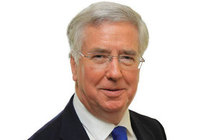Michael Fallon – 2016 Speech to RUSI Airpower Conference
Below is the text of the speech made by Michael Fallon, the Secretary of State for Defence, in London on 7 July 2016.
I’d like to begin by paying tribute to CAS since this is his last conference in post.
I know he’d rather I kept quiet but I want to put on record my appreciation for his immense leadership over the past three years.
He led the RAF into Shader only 2 years ago – he led calmly, without fuss.
I want to thank him for his leadership to the Force and service to the State.
He leaves a proud legacy.
A RAF stronger, more ready to face the challenges to come.
THE SOMME
Last week we commemorated the Somme.
Besides the contribution of our troops in the trenches, that long drawn out conflict witnessed a revolution in air power, from intelligence gathering to control of the air.
Back then, the perils of aviation were almost unimaginable.
Your forebears fought in canvas and wood, carried no parachutes, and had minimal training.
By contrast, you enjoy the sort of precision, speed and reach they could only dream of.
Yet you too continue to run risks to protect our freedom.
SHADER
And nowhere is this truer than in our fight against Daesh.
Two years on from Parliament’s vote to authorise airstrikes in Iraq, seven months since the extension of that authorisation to Syria, we now have over 600 air and ground crews in RAF Akrotiri.
It’s been humbling to meet those men and women on the frontline and to see how effectively they’re getting the job done.
GETTING THE JOB DONE
Our aircrew have flown more than 2800 missions in Iraq and Syria.
They’ve conducted 865 airstrikes in Iraq and, since December, 50 in Syria – more than any other nation except the United States.
Since December’s vote, the RAF has more than doubled its effort against Daesh.
Last month saw the greatest number of bombs dropped and missiles fired since January.
Meanwhile, RAF E-3D Sentry aircraft are co-ordinating Coalition aircraft over the whole operational area.
Our Voyager tankers are extending our reach and endurance.
Our intelligence gathering aircraft – such as Airseeker – are providing a significant amount of the Coalition’s ISR.
Together they’re ensuring our Tornados, Typhoons and Reapers can clear a path for brave Iraqi troops.
And our planes are making a decisive difference in support of local ground forces.
Daesh is on the back foot. It is a failing organisation.
In Iraq it has lost around 40% of the territory it once held.
Last week saw a significant milestone– the liberation of Fallujah.
Once more the RAF’s efforts highlight the precision nature of our operation.
Our fast jets struck more than 100 targets as Iraqi ground forces fought their way into the city.
It was our jets that destroyed bunkers housing anti-tank guns, weapons factories, ammunition dumps, and artillery.
They also provided crucial intelligence to identify potential threats even in the demanding circumstances of street-fighting in an urban environment.
Our efforts, alongside our Coalition partners, helped liberate Fallujah while limiting the long-term damage to the city and saving many brave Iraqi lives.
The symbolism of this latest success is inescapable since Fallujah was the first city seized by Daesh in Iraq in January 2014.
The focus is now on stabilisation so people feel safe to return home.
Meanwhile, in Syria the RAF is making inroads into Daesh’s command, control and targeting their oil infrastructure, a major source of revenue.
The RAF has not operated at this sustained operational tempo in a single theatre of conflict for a quarter of a century.
And this tempo and commitment – our precision targeting, our ISR, and our overall support for the coalition – shows no sign of abating.
GLOBAL REACH
Operation Shader might be our biggest operational focus but it’s only part of the RAF’s global activity.
Last year our pilots and aircrew deployed to more than 60 countries.
They’re in Eastern Europe for the third year running a protecting our NATO allies against Russian aggression.
Since April 29 they’ve been scrambled on 15 occasions to intercept 32 aircraft.
Besides targeting Daesh, our people are flying in Afghanistan as part of NATO’s Resolute Support Mission.
It remains a difficult and dangerous job.
And I’d like to pay tribute in to the personnel, especially the 2 RAF Puma crewmembers, who tragically lost their lives in Afghanistan in October last year.
Besides the RAF’s work overseas you continue to be a constant presence in UK as well as the Falklands skies providing Quick Reaction Alert to protect our security.
Whether at home or abroad, you continue to pull out all the stops.
The nation is proud of your service.
Thank you.
MAINTAINING A HIGH TEMPO
In the coming year I expect our RAF to continue, as you might say ‘kicking the tyres and lighting the fires’.
The result of the referendum will not change our global outlook.
Nor the shared threats we face.
To counter those international challenges…we must work even harder with our allies and partners, becoming, in the words of our SDSR, international-by-design.
And while we’ve opted out of one particular union, we take our global responsibilities seriously, as members of NATO, the Organisation for Security and Cooperation in Europe, the Northern Group of European nations, the Five Power Defence Arrangements in the Far East and permanent members of the UN Security Council.
But the RAF needs no reminding of its global obligations.
You’ve always been an instinctively international entity.
SDSR GOOD NEWS
But your challenge is to stay ahead of the curve.
Our competitors are striving to close the capability gap.
Russia is exploiting forward-swept wing technology, North Korea “miniaturising” nuclear weapons, others are making the most of cyber and fifth generation technology.
In response, our SDSR gives us a RAF that packs a more powerful punch, increasing its capital investment programme to more than £6Bn, so it can spend on our future air fleet.
For a sign of what’s to come look no further than our fifth generation F-35, which crossed the Atlantic last week, in time for RIAT and Farnborough.
The F-35 both land and sea-based will be the fulcrum of a new air fleet, including, 2 additional Typhoon squadrons, 9 Maritime Patrol Aircraft, 14 Voyager air-to-air refuelling aircraft by end of year, upgraded helicopter fleets, more than double the number of drones and investments in innovations like the solar-powered Zephyr.
We’re not just investing in the platforms but the weapons themselves.
Today I can announce a contract worth approximately £28 million to maintain our state-of-the-art Storm Shadow missile for the next five years.
This long-range high performance cruise missile is already in service with our Tornados and is being integrated with our Typhoons.
Last week it was deployed for the first time in western Iraq…destroying Daesh ammunition dumps in a large concrete bunker.
Collectively, these assets make our future air fleet among the most adaptable and agile in the world.
Yet, if we’re to seize the opportunities opened up by this new capability, the RAF must adapt in three ways.
1. INFORMATION
First, by responding to the growing information challenge.
What distinguishes the air technology we’re developing today is an increasing ability to absorb information.
From the images captured by the Tornado’s Raptor pods, to our AWACS, fusing and disseminating data.
From the continuous surveillance of Reaper, to our F-35.
Let’s consider F-35 for a moment.
The most powerful and comprehensive integrated sensor package of any fighter aircraft in history, a core processor that can perform more than 400 billion operations per second and 360-degree access to “real-time” battlefield information.
It immeasurably improves our situational awareness.
But to get to grips with all the data it provides our people must learn to sift it, understand it, and exploit it, to deliver a faster truth to the public, and a knock-out blow to our adversaries.
2. PEOPLE
This brings me to point two.
Our people must be able to keep up with the sophistication of our systems.
That means training our crews to make judgements about the intelligence in front of them.
It means making our organisation as a whole, more streamlined and more responsive, so that data distilled on the battlefield is interpreted by the analysts back home, all in real time.
That’s why we’ve brought components of Defence Intelligence community together at Joint Forces Intelligence Group Headquarters alongside the imagery intelligence capability of the Defence Geospatial Intelligence Fusion Centre.
But we don’t just need to improve our information handling skills.
As we develop our disruptive capability, whether in artificial intelligence, miniaturisation, or big data, the RAF will require an even more diverse palette of skills.
Yet today the nation is facing a skills deficit.
To bridge that gap we’re backing apprenticeships
The RAF currently has 2700 apprentices on its books – over half in aircraft engineering.
We’re also collaborating with Primes to create engineering pathways between public and private sector.
We’ve appointed a Defence Engineering Champion, Air -Marshal Julian Young to develop talent across the Single Services and the Civil Service.
And we’re opening up a new Air & Defence Career College in Lincoln, so budding engineers or computer scientists can have unrivalled access to the RAF and Air Defence industry.
3. PUBLIC AWARENESS
My third point is we have to help the public as well as our people adjust to this new phase in air power.
With more coverage on our use of UAVs like Reaper and our plans for Protector, with systems such as Zephyr and Taranis in development, there is concern about the level of automation.
So we must explain clearly the benefits of the capability we’re investing in and the safeguards in place.
We don’t wish to remove humans from the process but using unmanned systems minimises the danger to operators and aircrew in high threat environments.
Ultimately, we want to put more power into the hands of our people by giving them better information to make more informed decisions.
Human beings might lack the computational power of a machine, but they are better than machines at understanding human motivation in all its chaotic and complex unpredictability.
Our people will always be our greatest disruptive capability.
And that’s why we have a clear UK policy on automation of weapons systems: the operation of weapons systems will always be under human control.
We are committed to using remotely piloted systems as an absolute guarantee of oversight and authority for weapons release.
And our Science and Technology Programme does not fund research into fully autonomous weapon systems.
Although humans will remain in control of our future weapons systems, new technology is increasing the physical distance between man and machine.
Take our pilots controlling their RPAS remotely thousands of miles away.
Yet they remain subject to the moral and psychological burden of combat as well as Rules of Engagement and the Laws of Armed Conflict.
That means we have to ensure training, tactics, and doctrine meet the needs of the 21st century pilot.
CONCLUSION
So we’re preparing our people and the public to face the new dawn of airpower.
For the next generation, this will be a new age of opportunity.
Yet to make the most of it, we must make sure future talent keeps coming through the door.
In a sense. it’s the same appeal as Trenchard once made: “We want the mathematic genius – there is work for him. We want the scientific brain – there is more than enough work for him. We want the man of brains and we want the man of common sense. We want the man of initiative and the man of action”.
But that was in 1925 in the infancy of air power.
You can now look back on a century of extraordinary achievement and innovation.
From the tactical ingenuity on the Somme, to the feats of daring in the Battle of Britain.
From the breakthrough of the jet engine, to the development of an air-breathing rocket propulsion system that can enter earth’s orbit.
From the fifth-generation F-35, to the solar power zephyr that can loiter in the upper atmosphere.
Our people have helped to change this country. They’ve helped keep the world safe too.
So as we tell this story, as we appeal, let’s take to heart the theme of this conference and inspire the next generation.
They will be the ones to write the next chapter in the glorious history of our nation.
A history in which we’ll fly further and higher and longer than ever before, as they protect our country and keep our people safe.



